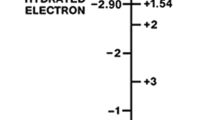Summary
-
1.
We have set up and measured artifical systems consisting of a non-oxidized and a corresponding oxidized substance, such as, alcohol and fatty acid, without metallic electrodes. These systems produce electromotive forces of the same direction and similar magnitude as they occur in living tissue, where, according toLund, increased oxidation (or respiration) shifts the potential to the positive side. Our models show the same relationship between oxidation and potentials.
-
2.
The electromotive forces of these artificial systems are composed of phase boundary potentials which depend upon the distribution of ions. Platinum or other metallic electrodes, as suggested by G.Marsh and byLund (according to his formulae), offer the least analogy.
Similar content being viewed by others
Author information
Authors and Affiliations
Additional information
The first seven parts of this series were from the Cleveland Clinic, but for the past one and one-half years work had to be continued at Louisville. This paper concludes the series.
Rights and permissions
About this article
Cite this article
Beutner, R., Lozner, J. The relation of life to electricity. Protoplasma 19, 370–380 (1933). https://doi.org/10.1007/BF01606235
Received:
Published:
Issue Date:
DOI: https://doi.org/10.1007/BF01606235




